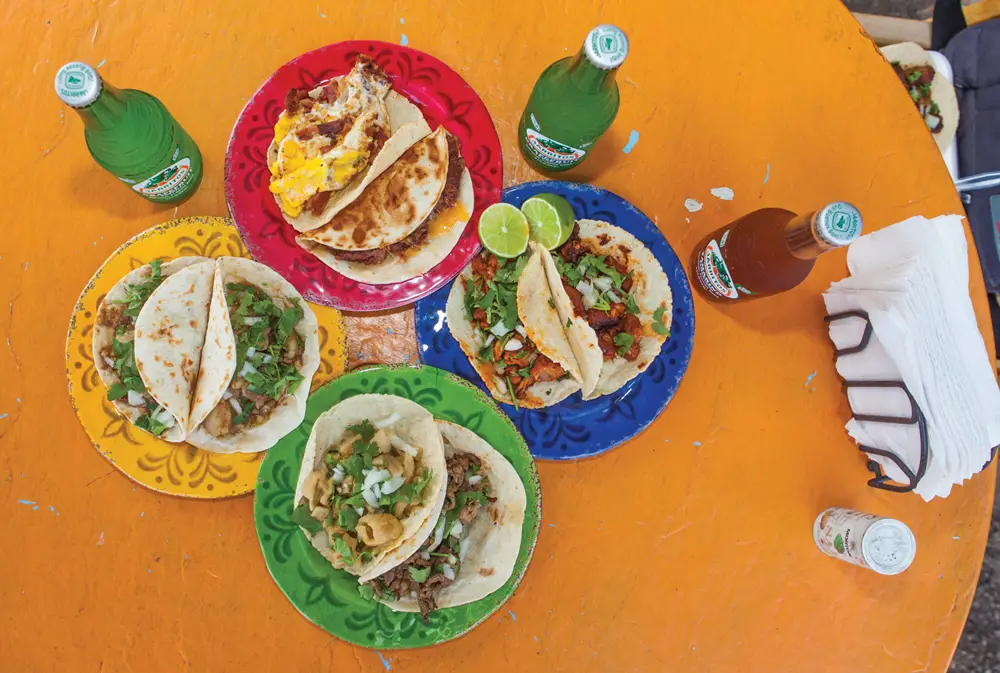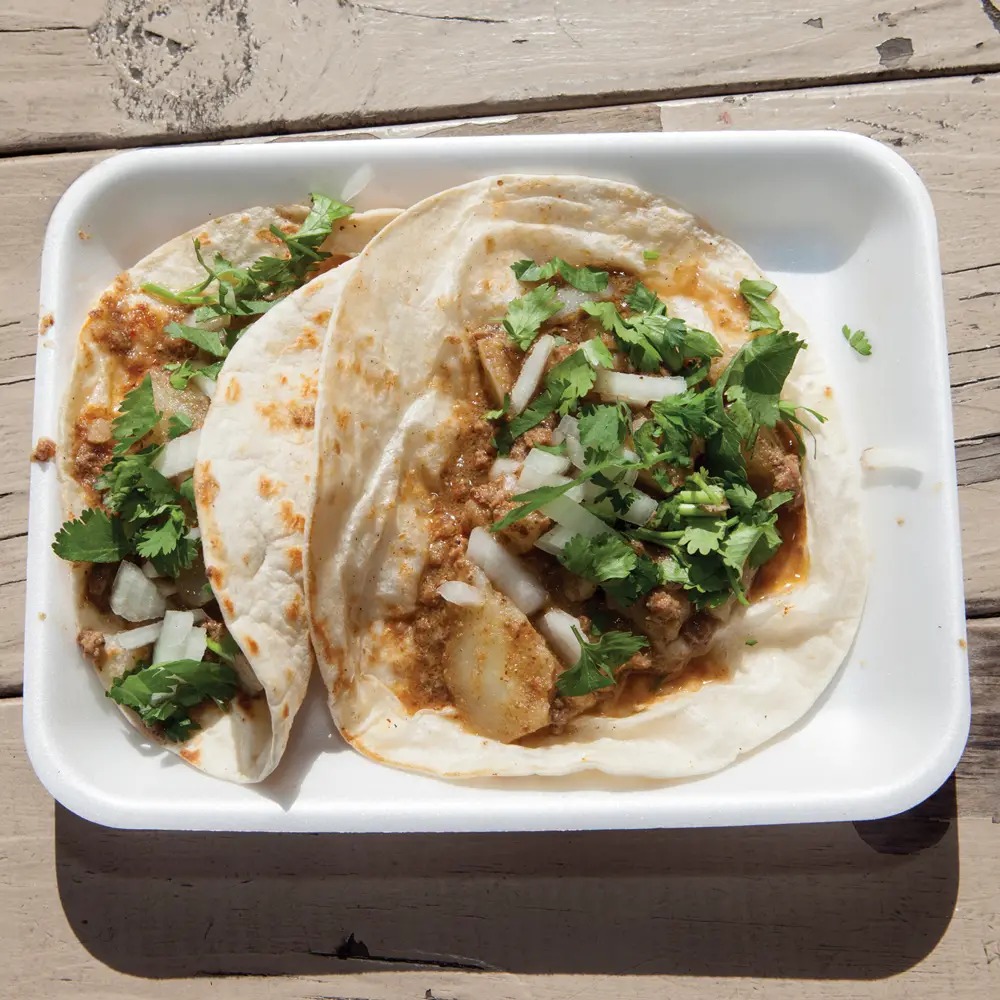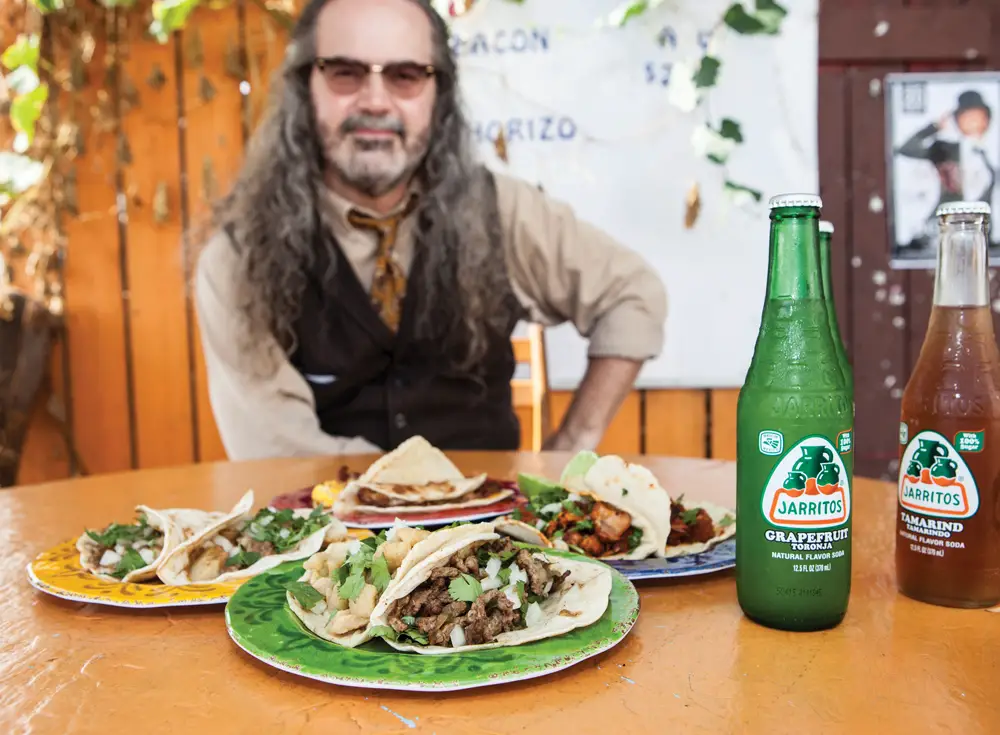Since Jan. 1, Mike Sutter has eaten more than 1,600 tacos.
He’s eaten staple tacos (migas, Veracruz All Natural), exotic tacos (tripitas, El Secreto De La Abuela), boring tacos (fajitas, El Jaclito), fancy tacos (fried snapper, Odd Duck), fusion tacos (banh mi, The Peached Tortilla), innovative tacos (tako taco, East Side King), infamous tacos (Don Juan, Juan in a Million) and remarkable tacos (bean and cheese, El Torito).
Why? For Sutter, eating all these tacos is a unique and necessary solution to a problem that most people don’t have. As the proprietor of the website fedmanwalking.com, Sutter needed a way to consistently populate his online domain with fresh content.
Restaurant reviews — the bread and butter of food critics — seem like the obvious option, but a fair review of any respectable restaurant demands a sizable investment, both of time and money. Sutter’s review of LaV, a fine-dining French restaurant in Austin, cost him $800 and six separate visits. More importantly, it took a month and a half to generate just one post.
“And one post every six weeks is internet suicide,” Sutter explains. Because there’s no way for a website to maintain traffic with such sporadic content, what he needed was a food that he could eat — and afford to eat — daily.
“I’ve drilled deep before,” he explains. “When I rolled out Fed Man Walking in 2011, I ate 115 burgers, and the year after that I did ‘I Can Eat 50 Eggs,’ and for 50 days in a row I ate an egg dish. Then after that I did every single barbecue restaurant in Austin.”
In addition to the practicality of the delicious Mexican foodstuff, there’s also a loftier explanation for Mr. Sutter’s taco walkabout. In Austin, and in Texas generally, tacos are life. They’re affordable, convenient, adaptable microcosms of Texan culture, and Sutter wanted to give them the exhaustive, informed coverage that Zagat and Buzzfeed’s “Top 10 Tacos You Have to Eat in _______,” fail to provide. He wanted to do right by the taco.
“I set it up with the idea of eating at a different taco place every day for 365 days, and then chronicling 500 tacos,” Sutter says. We were waiting in line at a trailer just off Cesar Chavez called Tacos Guerrero’s. It was a Saturday morning in September, and I was having trouble following his math.
“So some days I eat three or four tacos at one place, and then I write about those,” he says. “So the official count is around 300, even though it’s only been 260 days. It was a stupid way to set it up. I should have just said 500 days of tacos.”
His meandering, dare-I-say-inefficient path through these 500 tacos means he eats many more than he chronicles, resulting in what taco theologians, were there such a thing, would call a textbook felix culpa. The logic: Since there are way more than 500 taco spots in Austin (surprising, I know, but obvious if you think about it), he gets to pick and choose which he features.
This sets up a basic supply-and-demand situation. Because demand (taco joints) outstrips supply (365 days), the cream-of-the-crop tacos rise to the top. He gets to pick and choose exactly where he wants to go, so each choice is deliberate. That isn’t to say, of course, that he hasn’t kissed his fair share of frogs — he’s eaten some garbage tacos — it’s just that at least all the kissing has been consensual.
His odd selection process means he chooses restaurants democratically and judges tacos meritocratically: there is no preference, delineation or partiality toward the candidates. Authenticity (whatever that means), novelty, price and aesthetic are all noted, but only noted. The one true criterion, the lodestar by which the Fed Man Walks, is taste and taste alone.
Of course, this means different things for different tacos. Take, for instance, the bacon and egg taco Sutter ordered from Tacos Guerrero’s. Its short list of ingredients naturally handicaps its taste potential; a meal composed of only bacon, egg and tortilla can really only be so good. At the same time however, following a classically French line of reasoning, the paucity of ingredients means that mistakes have nowhere to hide, making the food’s quality and handling transparent.
“She cooked this bacon to order,” muses Sutter, chewing. “She didn’t make it at 6 a.m. and set it on the warm side of the grill. I worked fast food for nine years, and I can recognize a warmed-over piece of bacon when I see it.”
The tortillas too, plead their silent case before the judge. After ordering two picadillo and two al pastor, and one of each carnitas, carne asada, bean and cheese, picadillo, chicharrones, and bacon and egg, Sutter then asked Yolanda Guerrero en español whether or not she made her tortillas by hand.

The proprietress responded (or so I’m told) that she handmakes her corn tortillas, a statement that the mound of dough near her griddle corroborates. The flour tortillas, she admitted, come from a bag.
“It’s like red and white—it’s your preference,” Sutter says to me. “The purists will look at you and say, ‘I cant believe you’re getting that on flour,’ but it doesn’t matter what other people think. Sometimes it’s just about the taco. Like a fish taco, I’m always going to want a fish taco on corn because the earthy sweetness offsets the surf, makes it surf and turf.”
For these tacos, he had chosen maíz for all except the bean and cheese, for which Mr. Sutter considers harina to be the proper vessel. For the sake of context and journalistic accuracy, he makes sure to note whether the tortillas are handmade or store-bought, but he ultimately judges them using only the blind tongue of egalité. And in fact, at Tacos Guerrero’s, the handmade corn tortillas floundered.
“They’re not textured enough to me. They came out with a flat consistency that you’d expect out of a bag,” he says, disappointed. “She did make them nice and flexible, though. They didn’t break at the seams when you roll them to eat your taco, so a lot of credit there.”
The flour tortilla accompanying the bean and cheese, on the other hand, impressed. “Look at the respect she treats the flour tortilla with: she crisps it up on the grill, gives it color, even a regular out-of-the-bag tortilla can taste great. It’s like the puppet that becomes a real boy when you put it on the grill.”
But the humble frijoles y queso had even more up its sleeve. “The beans in the bean and cheese taco crisped up on the comal like that,” he says, invigorated. “If I were putting down my Top 5 Bean and Cheese Tacos right now, this would be in there. I’d come back as a civilian for that whether or not I was doing this series.”
Which naturally begs the question: Why is he doing this series? And perhaps more importantly, how?
First, it’s important to understand that Mike Sutter is no stranger to food or food writing. He worked for the Austin American Statesman for more than 25 years, starting as a copy editor and working his way up the ladder. By the end of his tenure, he had become the paper’s restaurant critic, a highly respected and massively influential mouth in the Austin food scene.
But then, in 2011, things changed.
The Statesman offered buyout contracts to more than 160 of its employees, Sutter included. “When they said, ‘We’ll give you a year’s pay with benefits and all you have to do is walk away,’ they didn’t have to hold a gun to my head,” he laughs. “It was voluntary. So we bought the contract for my youngest daughter, and it’s going to feel really good 12 years from now when she goes to school.”
But the problem remained: Mike Sutter, master tasteman, was out of a job. He tweeted on Thursday, June 23, 2011: “Friday’s my last day at The Statesman. A buyout too good to pass up. New handle: @fedmanwalking. Still hungry. Details TK.”
By Monday, if you can believe it, he’d landed an even dreamier dream job. A tech company called RSI, Renaissance Systems Inc., offered to pay him to run his blog and expense all his food-related costs.
If you’re wondering why a tech company would pay a food writer to eat 500 tacos, you’re not alone. “It’s hosted on their site,” he says. “It’s a way for them to say, ‘We do server hosting,’ and it’s a way of showing community engagement. It still makes no business sense to me, but I almost feel like I have a patron.”

Lest you worry that Mr. Sutter be swayed to favor taco establishments run by server-hosting corporations, fear not: Those do not exist. And even if they did, his ironclad integrity would persevere, as his years at The Statesman made the Fed Man into a consummate professional. He pays for everything (including the tacos for our interview), refuses to take anything without paying for it (including the gratis Jarritos Yolanda offered), writes his reviews on-site and will only reveal his mission and identity to owners after he’s eaten.
His armor of professionalism is a response to his time as a food critic, where for years every restaurant in Austin had a picture of Mike Sutter’s face taped to their POS systems. When a waiter told a manager that The Statesman food critic was at table nine, you better believe they tried to schmooze the hell out of him. As a result, Sutter tried to remain unrecognizable. When that failed, as it always inevitably fails, he became an expert in refusing special treatment.
“Invisibility is the greatest power a food critic can have,” says. But the irony is palpable: For years he tried in vain to remain anonymous, and now his new clientele have no idea who he is.
Which suits him just fine. The lack of preening allows Sutter to better judge the food. In fact, he’s come to find that the less ambiance and fuss a place has, the higher the likelihood is of the food being good.
“I want to see a place whose target customers are already there,” he says. “If I roll up to a working class taqueria wagon, and I see white work trucks, guys in painter clothes and mechanics, I’m feeling like I made a pretty good choice. Because they don’t have a lot of time, they’re probably value-conscious and they’re accustomed to food being authentic.”
And even though hasty — behind short-haired — is the last word I would use to describe Sutter, these first impressions provide a lot of valuable insight about the tacos he’s about to order. These Gladwellian moments and gut instincts don’t completely shape his judgments, but they do go a long way in informing them.
Like the taco Rain Man, Mr. Sutter surveys the scene: Is that a mocajete on the lip of the trailer? She must have just made the salsa. If there is al pastor on the menu, is there a trompo in the trailer? Are they serving migas? If they are, and they make their own tortillas, then the cut up tortilla strips mixed into the migas will elevate it beyond a lowly staple.
These snap judgments, made just by looking at the menu or even just the trailer itself, shape his opinions and expectations long before he sees a taco. To cut through the sensory overload, Sutter has developed a system.
“I have a couple of control tacos,” he says. “One is the bean and cheese, because if they make their own tortillas, that’s what’s going to showcase it the best. I’m also going to get carnitas because it’s kind of a rustic style taco, and if they can pull it off, then you know they’re doing a good job with other things.
“You also want to see how they treat the potato: Is it crispy and brown on the outside, do they treat them like homefries? Or is it just going to be hard and knobby: did they just chop them up and put too much of that nasty grill oil on them? That’s going to show you how they treat the fundamentals.”
Part of his attention to detail stems from the fact that after eating more than 1,600 “research tacos” in a little over 10 months, the critic has had to really start appreciating the narcissism of small differences.
Plus, food writing is difficult: There’s only so many ways that you can describe something that’s crispy. So when you combine this limited vernacular with eating the exact same food for 365 days, you end up having to get a little demiurgic with your descriptive adjectives.
“As a food writer,” he says, “I’m not really allowed to use the word delicious, because delicious means something different to every single person. A chef explained it to me when I started doing food writing. He said, ‘You know what the inside of a cigar box smells like, and you know what smoke feels like: bring common experience.’ That’s why I try to find metaphors to make people think how something might taste to them instead of just how something tastes to me.”

It also means that he’s constantly looking for a lead, something unique about each experience that can shape the story. When he ate at Torchy’s (he’s eating their “Taco of the Month” once a month for 12 months), their taco du mois was “Some Like It Hot,” a series of four tacos, all hotter than the next. He went outside with his tacos, and as soon as he did, an ambulance pulled into the parking lot.
“I thought, ‘This is just like one of those old horror movies where they make you sign a waiver in case you die of fright,’” he laughs. “Did Torchy’s decide to have an ambulance on hand just in case we fell out from these super hot tacos? That became my lead. You can’t sit behind your laptop in an office and come up with that.”
And so he doesn’t: Mr. Sutter’s commitment to accuracy and integrity — even more impressive given that he usually dines solo — is refreshing, commendable and, in a nutshell, the way food writing should be.
More importantly, it’s entertaining and smart. So, whether you consider Mr. Sutter and his mission more of a Don Quixote than an Edmund Hillary, it doesn’t really matter. In order to make any kind of impact, in any kind of field, you have to drill deep into a tiny niche, and I can think of worse niches than taco journalism.
Follow his adventures on fedmanwalking.com, or simply think of him next time you eat a taco; he’ll know.
















